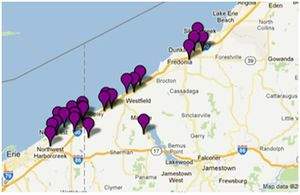The importance of a first impression; as a new contributor, I understand it all too well…
Will I be interesting, will I be informative, amusing, witty and knowledgeable…will I run out of adjectives?
The first impression of the Lake Erie Wine Country is, brace yourself, grapes! (So much for interesting, witty and amusing.)
A rather obvious statement I know, but this area is often referred to as the “Grape Belt.” The most common grape grown is Concord, a native variety that is most typically found sweetened and preserved and laying on top of your peanut butter in a peanut butter and jelly sandwich.Hundreds of thousands of tons of Concord are grown in the region and most of them are sold off to become grape jelly.
The wine trail is located in the southwestern corner of New York State, a short drive from Buffalo, extending into Pennsylvania. The Great Lakes appellation extends as far as Ohio. For the record, the wine trail was formerly known as the Chautauqua-Lake Erie Wine Trail, (shuh-taw-kwuh), is an Iroquois/Seneca word that translates to “where the fish are taken out”, or more loosely, fish lake.
Why am I bringing this up? It obviously has nothing to do with wine.
Wrong!
 Take a look at the map, and you’ll notice the proximity of the wineries to Lake Erie and Chautauqua Lake, “where the fish are taken out.”
Take a look at the map, and you’ll notice the proximity of the wineries to Lake Erie and Chautauqua Lake, “where the fish are taken out.”
These lakes have a cooling effect in the summer and more importantly a warming effect in the winter, helping to extend and moderate the growing season and protect the grapes.
In Lake Erie wine country, there are some lovely and wonderful wines to be had, along with friendly, and on occasion, colorful winemakers who will gladly chat with you about their pride and joy.
Most of the wineries take advantage of the native grapes, Vitis labrusca such as Concord, Niagara, Delaware, Isabella, Ives and Catawba to make some very interesting and fun wines. Don’t be put off by the abundance of wines made from the native grapes, I say embrace them.
You can also find some lovely fruit wines, made from apples, cherries or blueberries, which are wholly or partially from fruit other than grapes, although a few are grape based with fruit added. Yes, the wines from the native grapes and the fruit wines do tend to be on the sweeter side, but that doesn’t mean they aren’t tasty.
The bottom line — drinking wine should be a fun, pleasant experience. Here’s some fun and intriguing wines to be found along the trail:
Merritt Estate Winery: Two wines that come to mind that cover all the seasons, Sangria Wine Slush, (technically a pre-mix concentrate to make a frozen drink), for the spring and summer, this is the one and only time I will ever recommend adding ice to wine, pour it in a blender, add ice and viola. If you’ve ever been to the Taste of Buffalo, the largest two day food festival in the United States, you’ll be familiar with this. Mereo is the second wine, a sweet mulled wine that is perfect for the cool fall evenings and blustery winter nights. Heat the bottle, or a mug, on a coffee cup warmer and wow, does it give you that comfortable, Norman Rockwell feeling of hearth and home.
Johnson Estate Winery: The oldest, exclusively estate winery in New York State, whose tasting room just underwent a beautiful remodel. I’d recommend Golden Sparkles, a bright and fruity, sparkling Traminette, made in the traditional European method. Also GrapeàGranate – A wine made from Niagara grapes and blended with pomegranate juice. Definitely a fun summer wine. This is winery that I stop at every time I’m on the trail, if you’re lucky to be there when Mary and Nancy are pouring; you’re in for a treat.
Willow Creek Winery: Chautauqua Chocolate and Chocolate Temptations, two dessert wines with flavors of dark chocolate and fruit that truly stand out for you chocolate lovers.
Of course not everyone’s palate enjoys a sweeter-style wine, but never fear, the French-American hybrid varieties like Seyval, Vidal, Chambourcin, Chancellor, and Marechal Foch, which are typically dry in style can also be found throughout the trail.
The wineries do produce wines from classic European grapes such as riesling, chardonnay, merlot, cabernet franc, and cabernet sauvignon — all of which grow quite well there.
This is only just a glimpse into some of the exotic and I’ll say it again, fun wines to be found along the wine trail. There are rieslings to be had, Noirets, cabernet sauvignon, seyval blancs and tomato wines to experience. Yes, you read that right.
There are 23 wineries that belong to the Lake Erie Wine Country trail, 14 of which are in New York. You can easily skip over the border into Pennsylvania, no passport required, but of course there’s a toll if you’re traveling on the 90 Thruway, where you can find another nine wineries in close proximity in Pennsylvania.
On a closing note, if you’ve ever had the desire to make your own wine, you have to stop at Walker’s Fruit Farm in Forestville. They have a large variety of juice, from vinifera to fruit wines and all the supplies and instructions, even if you’re a novice. My wife and I, as novices in making wine, have made a number of batches over the years, if I can do it, you most certainly can too.

